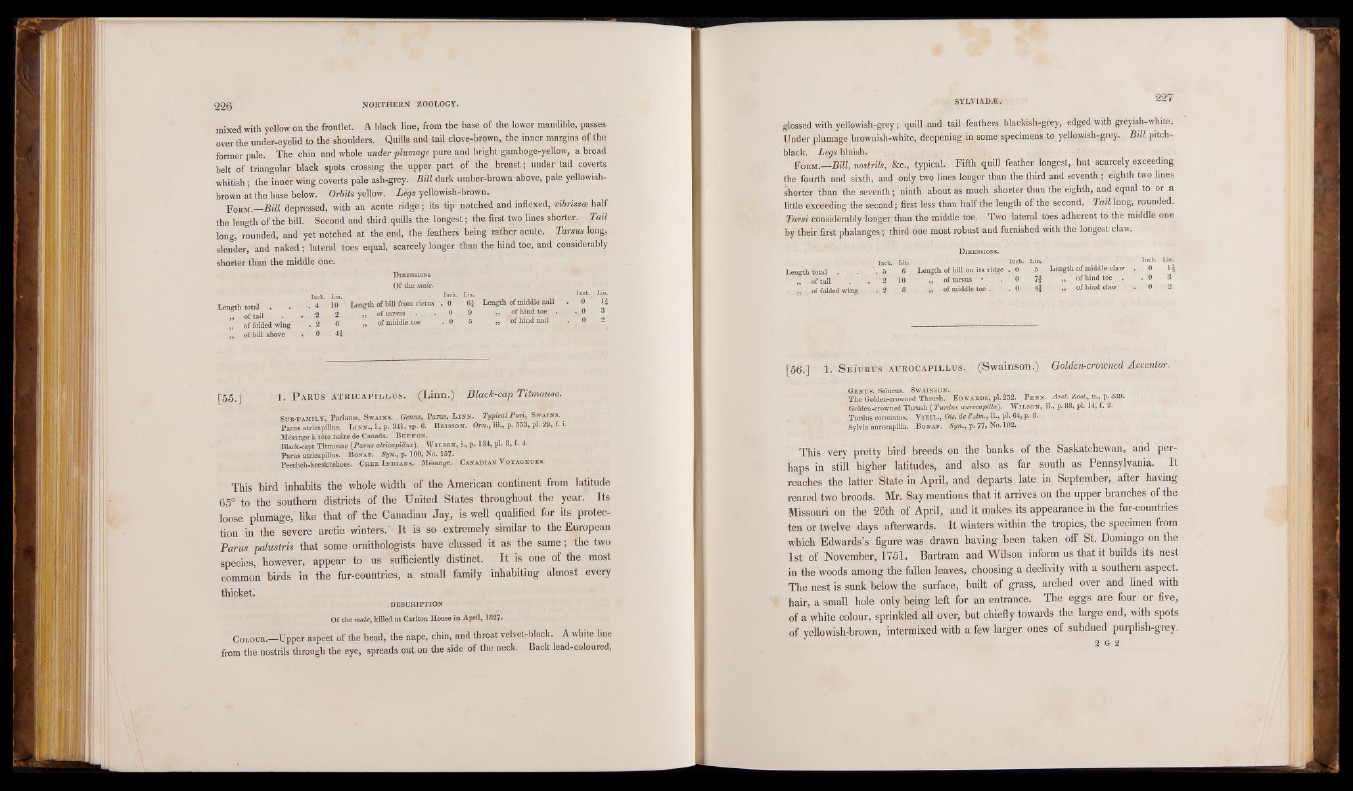
wit)l ye]low on the frontlet. A black line, from the base of the lower mandible, passes
over the under-eyelid to the shoulders. Quills and tail dove-brown, the inner margins of the
former pale. The chin and whole under plumage pure and bright gamboge-yellow, a broad
belt of triangular black spots crossing the upper part of the breast; under tail coverts
whitish; the inner wing coverts pale ash-grey. Bill dark umber-brown above, pale yellowish-
brown at the base below. Orbits yellow. Legs yellowish-brown.
F o rm .— S ill depressed, with an acute ridge; its tip notched and inflexed, vibrissas half
the length of the bill. . Second and third.quills the longest; the first two. lines shorter. Tail
long, rounded, and yet notched at the end, the feathers being rather acute. Tarsus long,
slender, and naked ; lateral toes equal, scarcely longer than the hind tbe, and considerably
shorter than the middle one.
Length total . 4
Lb.
10
„ . of tail » 2 2
of folded wing . 2 6
of bill above . 0 4 |
D im ensions
Of the male.
Inch. Lin.
Length of bill from rictus . 0 6i
„ of tarsus . 0 9
of middle toe • 0 5
- -Inch., Lip,
Length of middle nail . 0 1 |
„ of hind toe . ... 0 3
of hind nail . 0 2
[55.] 1. P a r u s a t r i c a p i l l u s . (Linn.)' Black-cap Titmouse.
Sub-fa m il y , Parian«, Sw ains. Genus, Paras, L i b s . Typical Pari, Sw a is s .
Paras atricapillus. Lib s .', i , p. 341, sp. 6. Brissos. Ora., iii., p. «53, pi. 29, f. i.
Mésange à tête noire de Canada. B u f f on. Black-capt Titmouse {Parus atricapillus). W il so n , i., p. 134, pi, 8, f. 4.
Parus atricapillus. B Peecheh-keeskæshees. onap. Syn., p. 100, No. 157. Cb.e e I n d ia n s. Mésange. Canadian V oya geu r s.
This bird inhabits the whole width of the American continent from latitude
65° to the southern districts of the United States throughout the year. Its
loose plumage, like that of the Canadian Jay, is well qualified for its protection
in the severe arctic winters.' It is so extremely similar to the European
Parus palustris that some ornithologists have classed it as the same ; the two
species, however, appear to us sufficiently distinct. It is one of the most
common birds in the fur-conntries, a small family inhabiting almost every
thicket. DESCRIPTION
Of the male, killed at Carlton House in April, 1827.
C o l o u r — Upper aspect of the head, the nape, chin, and throat velvet-black. A white line
from the nostrils through the eye, spreads out on the side of the neck. Back lead-coloured,
glossed with yellowish-grey ; quill and tail feathers blackish-grey, edged with greyish-white.
Under plumage brownish-white, deepening.in some- specimens to yellowish-grey. Bill pitch-
black. Legs bluish. • . ' ;
F orm .—Bill, nostrils, &c., typical. Fifth quill feather longest,, hut scarcely exceeding
the fourth and sixth, and only, two lines longer than the third and seventh ; eighth two lines
Shorter than the seventh ;’ ninth about as much shorter than the eighth, and equal to or a
little exceeding the second ; first less than half the length of the second. Tail long, rounded.
Tarsi considerably longer than the middle toe. Two lateral toes adherent to the middle one
by their first phalanges ; third one most robust and furnished with the longest claw.
D im en s io n s.
fnch. Lin. - • ' I»«*«- ^in.. ^ '• ' ; ..... Indfc' Ua‘ Length total . • .• . 5 6 Length of bill on its ridge -. 0 5 • Length of middle- claw . 0 14
J5 of tail . . 2 10 ‘ of tarsus • . 0 ’ 7f * of hind toe . . 0 3
.. . ” of folded wing 2. 8 , , of middle toe . . 0 4f ;, r of hind claw. • . 0 2
[56.] 1. S e i u r u s A U R O C A PiLLU S.i (Swainsoni])’. Golderircrowned Accentor.
Ge n u s , Seiurus. Swain so n . . The Golden-crowned Thrush. E dwa rds, pi. 252. P e n n . Arcl. Zool., ii., p. 339.
Golden-crowned Thrush ( Turdus awrocapilla). W il so n , ii., p. 88, pi. 14, f. 2.
Turdus; coronatus. Vie il ., Ois. de FAm ., ii., pi. 64, p. 8.
Sylvia aurocapilla. Bonap. Syn., p. 77j No. 102.
- This very pretty bird breeds on the banks of the Saskatchewan, and perhaps
in still higher latitudes, and also as far south as Pennsylvania. It
reaches the latter State in April, and departs late in September, after having
reared two broods. Mr. Say mentions that it arrives on the upper branches of the
Missouri on the 26th of April, and it makes its appearance in the fur-countries
ten or twelve days afterwards. It winters within the tropics,-the-specimen from
which Edwards’s figure was drawn having been taken off Si. Domingo on the
1st of November, 1751. Bartram and Wilson inform us that it builds its nest
in the woods among the fallen leaves, choosing a declivity with a southern aspect.
The nest is sunk below the surface, built of grass, arched over and lined with
hair, a small hole only being left for an entrance. The eggs are four or five,
of a white colour, sprinkled all over, but chiefly towards the large end, with spots
of yellowish-brown, intermixed with a few larger ones of subdued purplish-grey.
2 G 2